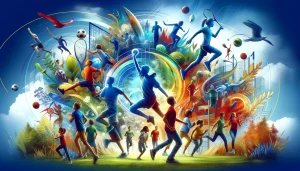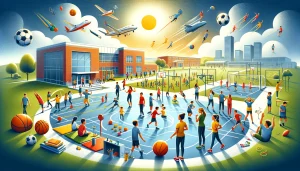Physical education, frequently sidelined in academic curricula, serves as a cornerstone in nurturing the holistic development of individuals. In the contemporary era dominated by rapid advancements and digital innovations, the significance of physical education cannot be emphasized enough.
Through this in-depth exploration, we endeavor to unveil the extensive advantages of physical education, spanning from bolstering physical health and fitness to enhancing mental well-being and fostering crucial social skills. By delving into both empirical research findings and practical anecdotes, our objective is to illuminate the pivotal role that physical education plays in facilitating comprehensive development.
In today’s sedentary lifestyles and screen-centric culture, physical education acts as a vital counterbalance, promoting physical activity and healthy habits among individuals of all ages. Furthermore, it serves as a catalyst for sharpening cognitive functions, reducing stress, and enhancing social interactions.
By understanding the multifaceted benefits of physical education, we can appreciate its indispensable contribution to molding well-rounded individuals equipped to navigate the complexities of contemporary society.
What is Physical Education?

Physical education encompasses a diverse array of activities designed to enhance students’ physical competencies, fostering confidence and enjoyment in various physical endeavors. Beyond honing motor skills, physical education yields a myriad of benefits spanning mental, social, emotional, and cognitive development.
Through structured physical activities and sports, students not only build physical strength and endurance but also cultivate resilience, teamwork, and leadership skills. Moreover, engaging in physical education promotes mental well-being by reducing stress and anxiety while enhancing focus and concentration. It also facilitates social interaction and camaraderie, fostering a sense of belonging and community among students.
By recognizing the holistic benefits of physical education, educators and policymakers can prioritize its integration into academic curricula, ensuring that students receive a well-rounded education that nurtures their physical, mental, and social well-being.
Read Here: why classical education is bad
Physical Health and Fitness:
1. Promoting Physical Health:
Physical education classes are essential for promoting physical health among students. These classes offer valuable opportunities for students to engage in regular physical activity, which is crucial for cardiovascular health, muscle strength, and endurance.
By participating in structured physical activities and sports, students can maintain a healthy weight and reduce the risk of obesity, diabetes, and other chronic diseases.
2. Developing Motor Skills and Coordination:
Structured physical activities and sports provided in physical education classes play a significant role in the development of fundamental motor skills, coordination, and agility.
Students learn how to control their movements, improve their balance, and enhance their overall physical capabilities. These skills serve as a foundation for a lifetime of active living, as they can be applied to various sports and physical activities outside of the classroom.
3. Enhancing Mental Well-being:
Physical education classes contribute to the overall well-being of students by promoting mental health and enhancing cognitive functions. Regular physical activity has been shown to improve concentration, focus, and memory, leading to better academic performance.
Additionally, it helps in reducing stress and anxiety, providing students with an outlet to release pent-up energy and improve their overall mood.
Academic Performance:
Positive Correlation with Academic Achievement:
Numerous studies have demonstrated a positive correlation between physical activity and academic performance. Students who participate in regular physical education classes often exhibit better performance in classroom tasks and standardized tests compared to their less active peers.
Engaging in physical activity not only improves physical health but also positively impacts cognitive abilities, leading to enhanced academic outcomes.
Stimulation of Brain Function:
Physical activity stimulates brain function by increasing blood flow and oxygenation to the brain. This enhanced circulation improves cognitive skills such as memory, attention, and problem-solving.
Students who regularly participate in physical education classes are better equipped to focus, retain information, and effectively process complex concepts, ultimately leading to improved academic performance across various subjects.
Promotion of Healthy Lifestyle and Mental Alertness:
Physical education classes play a crucial role in promoting a healthy lifestyle and enhancing mental alertness among students. By incorporating regular physical activity into their routine, students develop habits that support overall well-being, including physical health and mental clarity.
As a result, students are more engaged in their academic pursuits, demonstrating increased motivation, participation, and academic success.
Overall, physical education contributes to improved academic performance and student engagement by fostering a holistic approach to education that prioritizes both physical and mental health.
Social Skills and Teamwork:
Peer Interaction and Communication:
Physical education classes provide valuable opportunities for students to interact with their peers in a supportive and active environment. Through group exercises, team sports, and cooperative games, students develop essential social skills such as communication, cooperation, and collaboration.
These interactions enable students to practice effective communication strategies, express their ideas, and work together towards common objectives.
Lessons in Leadership and Sportsmanship:
Engaging in team sports and group activities within physical education settings teaches students important lessons in leadership, sportsmanship, and fair play. Students learn to take on leadership roles, delegate tasks, and motivate their teammates towards shared goals.
Additionally, they develop a deeper understanding of sportsmanship, learning to respect opponents, follow rules, and accept both victory and defeat graciously.
Appreciation of Diversity and Respect for Others:
Through collaborative efforts and shared experiences in physical education classes, students learn to appreciate diversity and respect others’ abilities and perspectives. Working alongside peers of different backgrounds, skill levels, and interests fosters a sense of inclusivity and understanding.
Students learn to celebrate each other’s strengths, offer support to overcome challenges, and embrace the unique contributions of every team member. These experiences promote empathy, tolerance, and a sense of unity among students, preparing them to navigate diverse social contexts with respect and empathy.
Lifelong Habits and Healthy Choices:
Building a Foundation for Physical Activity:
Physical education serves as the cornerstone for establishing lifelong habits of physical activity and healthy living. Through regular participation in physical education classes, students develop a routine of engaging in various forms of exercise, whether through structured activities, sports, or recreational games.
By integrating physical activity into their daily lives, individuals are more likely to prioritize their health and well-being as they grow older.
Cultivating a Love for Exercise:
Physical education plays a crucial role in instilling a love for exercise and outdoor recreation from a young age. By providing enjoyable and engaging activities, physical education classes create positive associations with physical activity, making it more likely for individuals to continue exercising throughout their lives.
Whether through team sports, individual fitness challenges, or outdoor adventures, students develop a lifelong appreciation for staying active and maintaining a healthy lifestyle.
Empowering Informed Choices:
In addition to promoting physical activity, physical education educates students about the importance of nutrition, exercise, and overall wellness. By learning about the benefits of healthy eating habits, regular exercise, and stress management techniques, students are empowered to make informed choices about their health.
Armed with knowledge about the impact of lifestyle choices on their well-being, individuals are better equipped to adopt healthy behaviors and sustain them over the long term, leading to improved overall health and quality of life.
Read Here: how to become a special education teacher
Inclusivity and Accessibility:

Ensuring Equal Opportunities:
Physical education programs should prioritize inclusivity and accessibility, ensuring that all students, regardless of their physical abilities or backgrounds, have equal opportunities to participate. This commitment to inclusivity fosters a supportive and welcoming environment where every student feels valued and respected.
Adaptive Physical Education:
Adaptive physical education programs are essential for accommodating students with disabilities and ensuring their full participation in physical activities. These programs tailor activities and exercises to meet the individual needs and abilities of students, promoting inclusivity and diversity within the classroom.
By providing adaptive physical education, schools demonstrate their commitment to supporting the diverse needs of all learners.
Fostering a Sense of Belonging:
Inclusive physical education practices go beyond accommodating students with disabilities to create an environment where every student feels included and valued. By catering to the needs of all students and offering modified activities when necessary, physical education fosters a sense of belonging and equality among learners.
This promotes social cohesion and mutual respect, contributing to a positive and inclusive school culture.
Read Here: how to become educator
Conclusion:
In conclusion, physical education stands as a cornerstone in fostering holistic development and overall well-being across all age groups. Its impact spans various domains, including physical health, mental well-being, academic performance, and social skills. By engaging in regular physical activity, individuals not only improve their cardiovascular health, muscle strength, and endurance but also experience reduced stress, anxiety, and depression. Moreover, physical education enhances cognitive functions, such as memory, attention, and problem-solving, leading to better academic performance and student engagement.
Beyond the physical and mental benefits, physical education cultivates essential social skills like communication, cooperation, and teamwork, preparing individuals for success in various social settings. By instilling lifelong habits of physical activity and healthy living, physical education lays a strong foundation for long-term well-being and quality of life.
In light of these profound impacts, it is imperative to prioritize physical education in educational curricula and policies. By doing so, we empower individuals to lead healthier, happier, and more fulfilling lives, thus shaping a brighter future for generations to come. Let us continue to recognize and value the invaluable role of physical education in nurturing the well-rounded development of the future generation.
